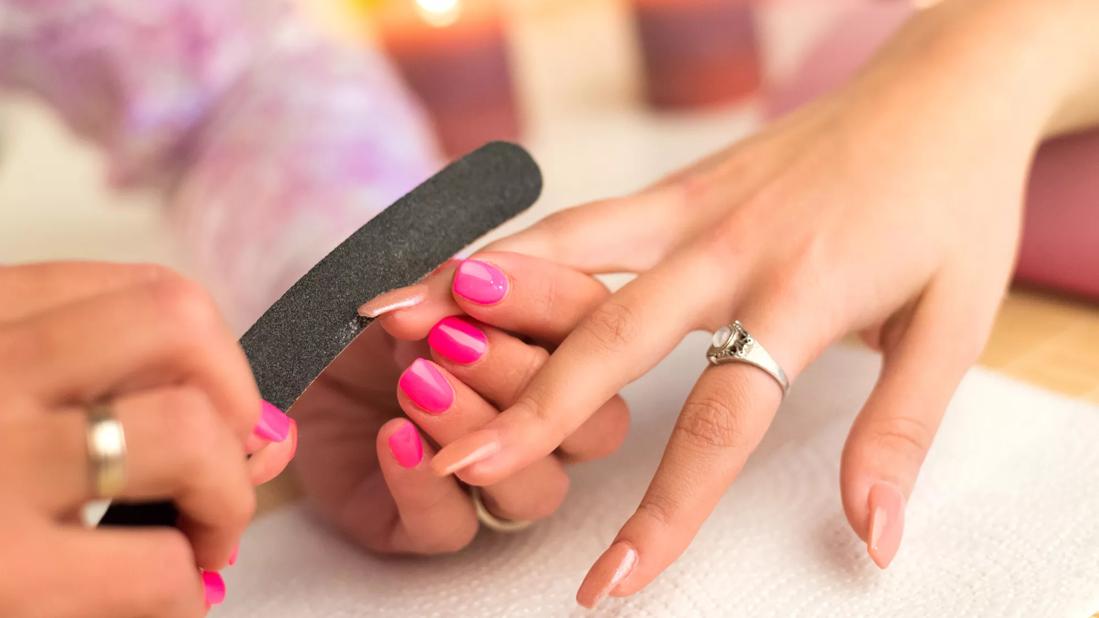Before your next manicure, weigh the reward against the risk of infection, irritated skin and damaged nails

Having long, strong nails can make you feel beautiful and put together. That’s why so many people use nail care products. But if your natural nails aren’t getting the job done, you may be considering acrylics.
Advertisement
Cleveland Clinic is a non-profit academic medical center. Advertising on our site helps support our mission. We do not endorse non-Cleveland Clinic products or services. Policy
“Acrylic nails have been around much longer than some of the gels and dips that are growing in popularity,” says dermatologist Amy Kassouf, MD. “But they do have some risk.”
While acrylic nails give the impression of strong, healthy nails, they may damage your skin, nails and general health. The substance in acrylic nails can make your natural nails thinner and weaker. Plus, the chemicals used to apply and remove the nails can irritate your skin.
Dr. Kassouf shares what you need to know about wearing acrylic nails.
Acrylics are a type of fake nail formed from a chemical paste made from powder and liquid materials. The mixture attaches to your existing nail and can be molded to your desired shape. Once air exposure hardens the acrylic nail, it can be filed and polished.
“Your natural nail consists of a top plate and a bottom plate that stick to the skin below it (nail bed),” Dr. Kassouf explains. “Roughing up the top plate allows the acrylic coating to bond. Once the coating hardens, it makes your nails very stiff and strong.”
An acrylic nail set can last up to eight weeks. But they aren’t maintenance-free. As your natural nail grows and your acrylic coating moves away from your cuticle, you’ll need a touch-up or “fill” every two to three weeks. A nail technician adds acrylic to the gap between the acrylic and cuticle.
Advertisement
Getting fills regularly can:
Acrylic nails can have unhealthy side effects. But not everyone who wears them will have issues.
Know the risks associated with acrylics so you can identify health issues quickly. Acrylic nails may:
More than 70 million Americans live with allergic contact dermatitis (ACD), a reaction or sensitivity to certain substances touching their skin. Acrylates, the ingredient that helps acrylic nails harden, is commonly associated with ACD.
Acrylic monomers, the small molecules in the acrylic coating, can cause reactions to the skin around your nails, including:
But Dr. Kassouf says your eyelids may be the first place you notice signs of ACD.
“Your eyelids are the thinnest skin on your body, so you’re more likely to get an initial reaction on your eyelids than you are on the thicker skin around your nails,” she notes.
The process of applying and removing acrylics can be just as harmful, if not more harmful, than the acrylics themselves.
Nail damage happens because of:
“Taking acrylics off can damage or even remove the top plate of your nail,” Dr. Kassouf says. “You can end up with very weak or brittle nails for about six months before the healthy nail grows enough to replace it.”
The bond between an acrylic nail and your nail plate is stronger than the bond between your nail plate and nail bed. As a result, people with acrylic nails are more likely to experience onycholysis, when their nail plate separates from their nail bed.
“Natural nails are flexible, but acrylic nails aren’t,” Dr. Kassouf says. “Everyday activities such as typing and cooking cause trauma to acrylic nails. These movements stress the area where the nail adheres to the nail bed.”
That stress can cause the nail to pull away from the skin underneath it.
Onycholysis is rarely painful, and a new nail can grow and attach to the nail bed successfully. But the condition does carry a risk of infection.
Acrylic nails can raise your risk for infection in several ways:
Advertisement
Fungal infections (onychomycosis) are the most common infections associated with acrylic nails, but bacterial infections can also occur.
“After removing your acrylic nails, you may see a gap underneath,” Dr. Kassouf says. “If fungus grows in that space, the area may look green, brown or yellowish and be crumbly. Bacterial infections tend to be inflamed and sore.”
The safest nail treatment is nontoxic polish, says Dr. Kassouf. But if you’re looking to add length or strength to your nails, try a manicure option that causes less trauma than acrylics:
Advertisement
If you get acrylic nails, take steps to reduce the damage to your nails, skin and general health:
“Once you remove your acrylic nails, you have to commit to letting your natural nails grow out,” Dr. Kassouf states. “Keep your nails relatively short, use a strengthening polish and moisturize a lot — anything to keep the skin and nail area flexible and healthy.”
Advertisement
Learn more about our editorial process.
Advertisement

Strengthening your skin barrier, simple routines and minimizing products are ongoing, popular trends

Moisturizing, running a humidifier and adjusting your showers may help keep itchiness and irritation at bay

Glycolic acid benefits skin tone, texture and pigmentation by exfoliating dead skin

Some gentle soap and warm water go a long way when you’re washing these cosmetic tools regularly

New formulas are less drying and contain water-based and skin-loving ingredients

At a minimum, in the morning, apply a cleanser, followed by a moisturizer and sunscreen, in that order

The convenient option is good for touch-ups, but it shouldn’t replace your traditional sunscreen

Olive oil works as a skin moisturizer, but it’s not right for everyone

Start having sex about 72 hours before ovulation, then at least every other day during your fertile window

Attachment theory suggests that your earliest relationships shape connections throughout your life

It isn’t a recognized mental health disorder, but research shows that problematic social media use can negatively affect your mental health, self-esteem and sleep